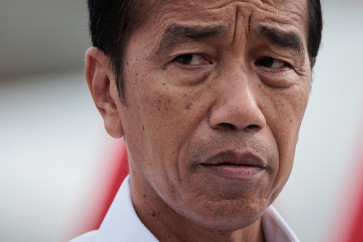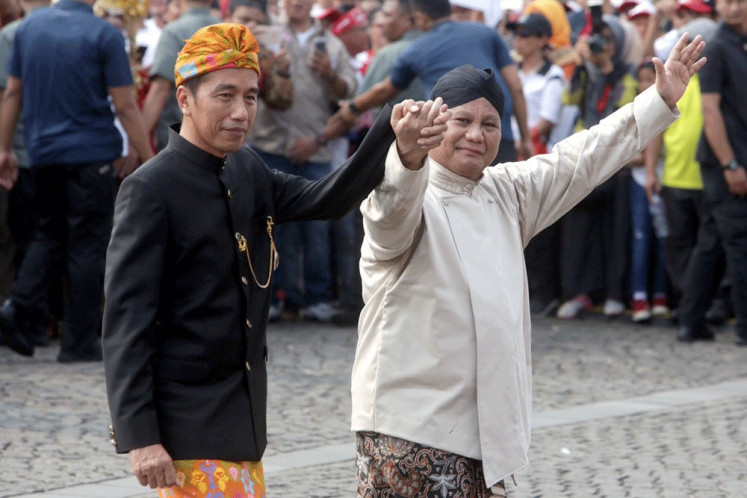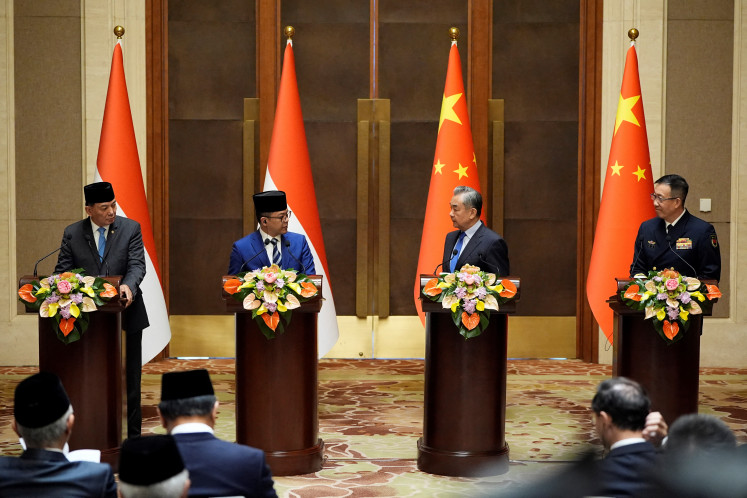Cyberbullying: A headache under ITE Law
Through Article 45B of the new amendment of the Electronic Information and Transactions (ITE) Law, cyberbullying is now finally considered as a form of harassment, and a criminal act that carries a maximum imprisonment term of four years and/ or fines amounting to Rp 750,000 (US$55.55).
Change text size
Gift Premium Articles
to Anyone
 Illustration of a buzzer committing cyber attack through internet. (Shutterstock/File)
Illustration of a buzzer committing cyber attack through internet. (Shutterstock/File)
I
t seems that people are getting meaner and meaner in every corner of the wilderness known as social media. For example, consider the recent case of cyber-harassment involving a producer of a local private TV station, which was triggered by a tweet made by the producer seven years ago regarding a “sexual joke” about a large religious organization. Eventually, the producer had to delete their Twitter account.
Other cases involve mockery and defamation of celebrities’ personal lives on social media or even harassment on the basis or different political opinions.
These kinds of cases are generally known as “cyberbullying”. Merriam-Webster defines bullying as an act or written or spoken words intended to intimidate of harass a person, or to cause physical harm to a person or his/her property, while cyberbullying is simply an act of bullying in cyberspace.
Most of the time, cyberbullying occurs in the school environment among children or teenagers, thus the laws of the United States tackle the problem as one of school safety. Singapore on the other hand imposes criminal charges on any person who harasses, alarms or distresses another person.
What about Indonesia? Through Article 45B of the new amendment of the Electronic Information and Transactions (ITE) Law, cyberbullying is now finally considered as a form of harassment, and a criminal act that carries a maximum imprisonment term of four years and/ or fines amounting to Rp 750,000 (US$55.55).
Note that such a provision is aimed at anyone who deliberately harasses or sends frightening information to another person. Furthermore, Article 45B of the new ITE Law explicitly sets out two additional elements for something to be classified as cyberbullying, namely: (1) Threats of violence or frightening information; and (2) Causing physical, mental and/or financial damages. Hence, only acts of harassment that meet those parameters can be categorized as cyberbullying.
The provision on cyberbullying looks promising on paper, but its efficacy remains questionable. Cyberspace is a domain in which anyone or anything (e.g. robots) can take on an identity and commit cyberbullying and therefore enforcement of the law will be a bit tricky.
There are five potential issues with regard to combating cyberbullying. The initial challenge is to determine whether a given act constitutes cyberbullying. This will be problematic because cyberbullying requires physical, mental and/or financial damage to begin with. Most cyberbullying cases affect the mental wellbeing of a person and unfortunately measuring mental damage is very subjective, thus it may vary in each case.
Another element is financial damage, which looks easy to prove because victims only have to establish financial losses they have suffered from cyberbullying. In fact, it is quite difficult unless it is crystal clear that an act of bullying constitutes blackmail. For example, a celebrity may claim to be suffering from a declining number of job offers because of a rumor spread in cyberspace. The financial loss is there, but determining whether it is a result of the rumor will definitely be a headache for law enforcers.
It is hard enough to imagine someone being physically damaged by cyberbullying, but there may be cases of physical violence that eventuate because of mere conflicts on social media.
Second, there are certain conditions under which cyberbullying happens. Take the case of a female student who mocked Yogyakarta on social media. Logically, she was the one who started the fire, but subsequently she was on the receiving end of massively bullying in cyberspace. Could this unfortunate girl countercharge those who had bullied her under the cyberbullying provision even though she also violated the ITE Law? The answer depends on the judges’ approach: whether they consider the act as cyberbullying or another exercise of freedom of speech.
Third, as stated before, cyberspace is filled with anonymous users because it does not require much effort to make a fake online identity or use a robot to make one. Not to mention that evidence of cyberbullying is highly vulnerable to tampering as deleting a comment from social media could remove all traces of an alleged crime.
However, just take a leap of faith and imagine that bullies’ identities are traceable, will investigators be able to catch them? The fourth issue is a result of the borderless world of cyberspace, which enables information to spread fast, thus the chance of cyberbullying is multiplied and the number of bullies could easily reach thousands in hours. Furthermore, we can post harsh comments with just a few movements of our thumbs, thus the number of bullies of a certain individual could be a massive number of people.
Investigators are only likely to be able to catch the provocateurs, not the entire digital lynch mob.
The last interesting legal issue concerns the nationality of the bullies. It is highly likely that cyberbullies are foreigners considering the borderless nature of cyberspace. Therefore, will Indonesian court verdicts be enforceable for cyberbullies overseas? That will be a classic problem of legal jurisdiction. Note that this cross-border issue was also debated in the implementation of the infamous “right to be forgotten” provision in the Google Spain case.
These issues are those that are most likely to arise and if the government cannot find a way of closing these loopholes the new ITE Law will contain nothing but meaningless provisions. Then again, the key will be in how judges set the parameters of cyberbullying. Indonesian citizens should put their faith in the nation’s judges along with the problematic implementation of defamation in the ITE Law.
Finally, the best way to avoid cyberbullying is to behave in cyberspace, as netizens are ultimately the harshest judges.
Investigators are only likely to be able to catch the provocateurs, not the entire digital lynch mob.
---------------
We are looking for information, opinions, and in-depth analysis from experts or scholars in a variety of fields. We choose articles based on facts or opinions about general news, as well as quality analysis and commentary about Indonesia or international events. Send your piece to community@jakpost.com. For more information click here.









